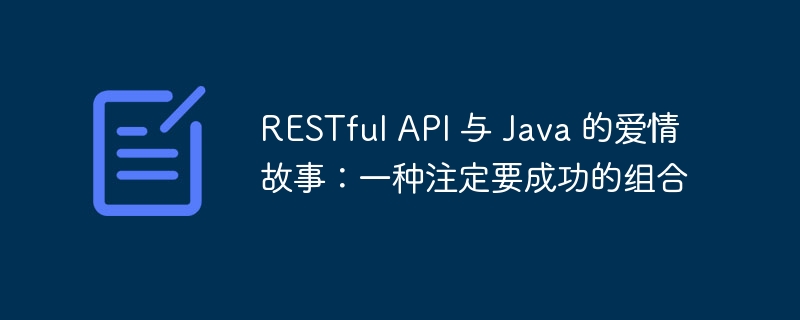Home >Java >javaTutorial >The love story of RESTful APIs and Java: a combination destined for success
The love story of RESTful APIs and Java: a combination destined for success
- 王林forward
- 2024-03-28 09:20:18900browse

php editor Xiaoxin will show you the secrets of matching RESTful API and Java. In today's Internet application development, RESTful API has become an important bridge connecting the front and back ends, and combining Java as a back-end development language is a combination destined to succeed. This article will delve into how to effectively use RESTful API and Java to cooperate with each other, and provide developers with practical guidance and tips to make your project more successful and efficient.
- Unified interface: RESTful api Use unified resource identifiers (URIs) and Http verbs to access and manipulate resources, simplifying client and Communication between servers.
- Stateless: RESTful APIs are stateless in nature, which means that each request is independent and no contextual information is stored on the server side.
- Cacheable: RESTful API supports caching mechanism, which improves performance and reduces server load.
- Scalability: The RESTful API is easily scalable to accommodate growing user base and data volume.
Advantages of Java
- Cross-platform: Java is a cross-platform language that can run on any operating system that supports Java Virtual Machine, thus ensuring the reliability of the application Portability.
- Robustness: Java is known for its robustness and reliability, which helps in creating stable APIs.
- Object-oriented: Java is an object-oriented language that enables developers to create reusable, maintainable code.
- Extensive libraries: Java has a rich set of libraries, including JAX-RS, which is specifically designed for building RESTful APIs.
The combination of RESTful API and Java
The combination of RESTful APIs and Java provides significant advantages in the following areas:
- Web Services Development: Java and RESTful APIs form an ideal foundation for creating robust and reliable WEB services.
- Mobile Application Development: RESTful API and Java make it easy to develop mobile applications that interact seamlessly with the server.
- Microservice architecture: RESTful APIs and Java are useful for building lightweight, independently deployable microservices.
- Cloud Computing: RESTful APIs and Java are popular in cloud computing environments for creating distributed and scalable applications.
Case Study: Spring REST
spring REST is a popular Java framework that simplifies the development of RESTful APIs. It significantly reduces the time and effort required to develop and maintain RESTful APIs by using annotations, configurations, and out-of-the-box components.
A key feature of the Spring REST framework is its support for a variety of data binding formats, including JSON, XML, and form data. It also provides automatic validation, exception handling, and documentation capabilities, further enhancing the stability and ease of use of the API.
Best Practices
In order to get the most out of the combination of RESTful APIs and Java, it is crucial to follow some best practices:
- Follow RESTful principles: Always follow RESTful principles, such as using unified URIs and HTTP verbs.
- Use the appropriate data format: Select the appropriate data format based on the needs of your application, such as jsON or XML.
- Protect your API: Protect your API from unauthorized access using authentication, authorization, and rate limiting measures.
- Perform unit testing: Unit test your API to verify its behavior and ensure its robustness.
in conclusion
The combination of RESTful APIs and Java is a combination destined for success, providing unparalleled advantages for modern web development. By leveraging the uniformity, statelessness, and extensibility of RESTful APIs with the cross-platform, robustness, and extensive libraries of Java, developers can create applications that are robust, reliable, and scalable.
The above is the detailed content of The love story of RESTful APIs and Java: a combination destined for success. For more information, please follow other related articles on the PHP Chinese website!

